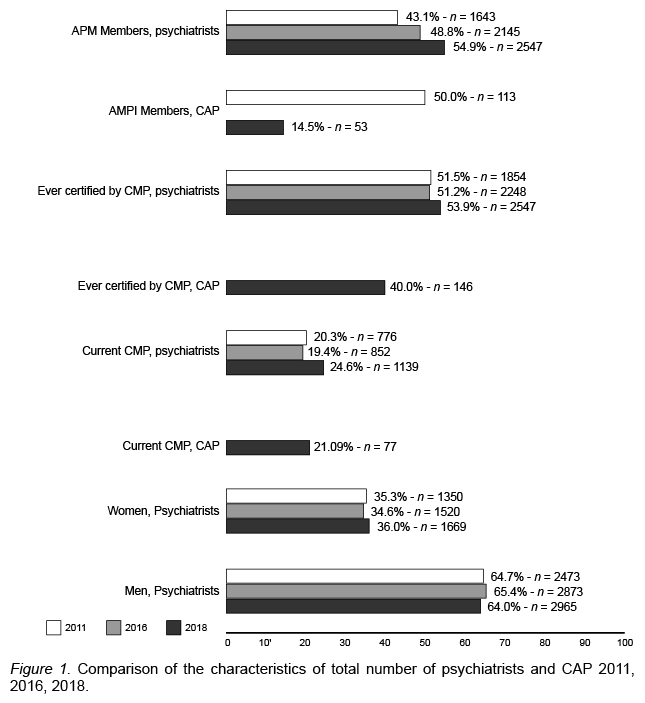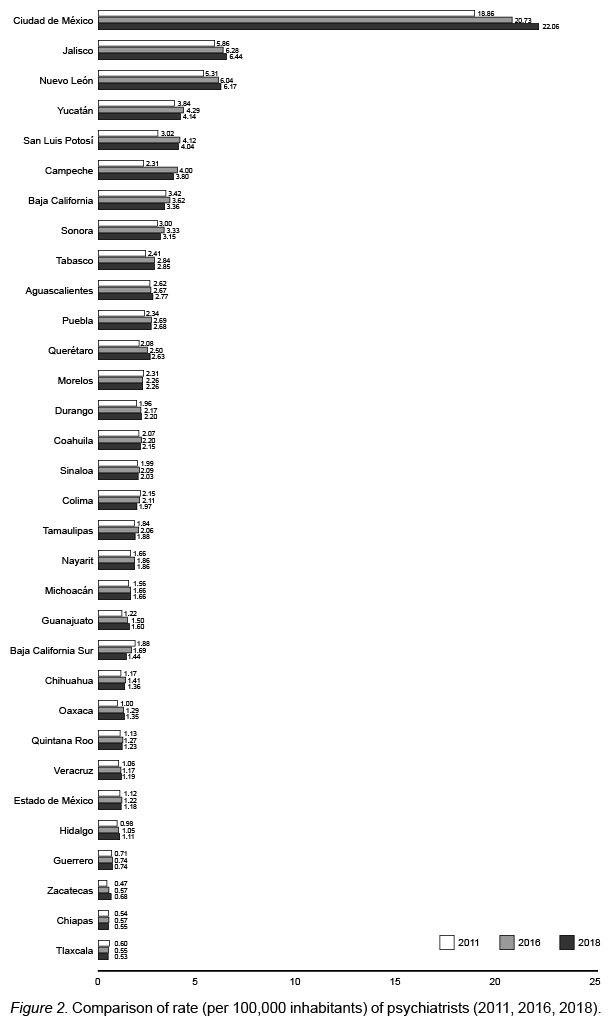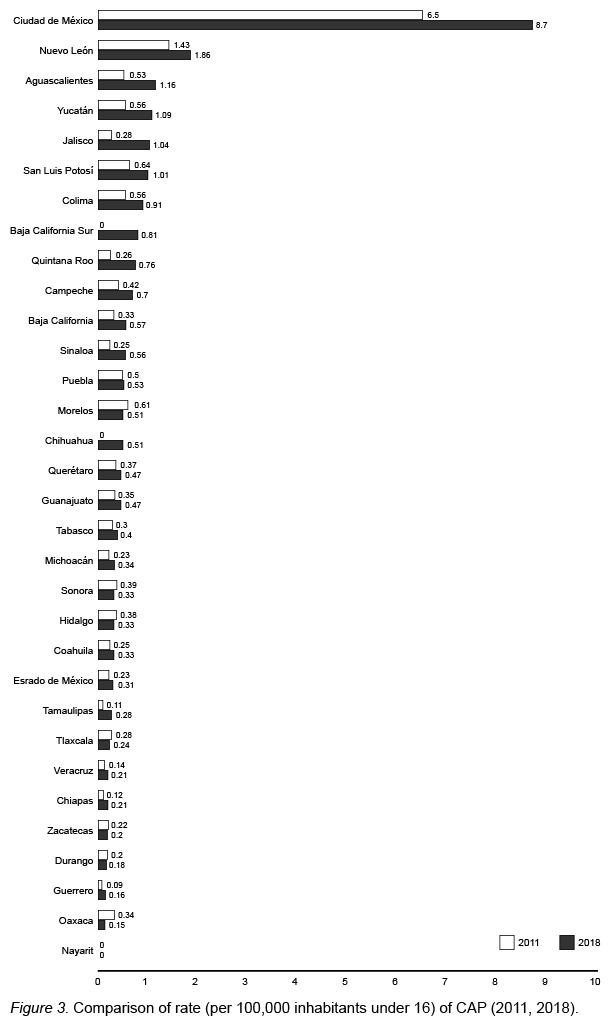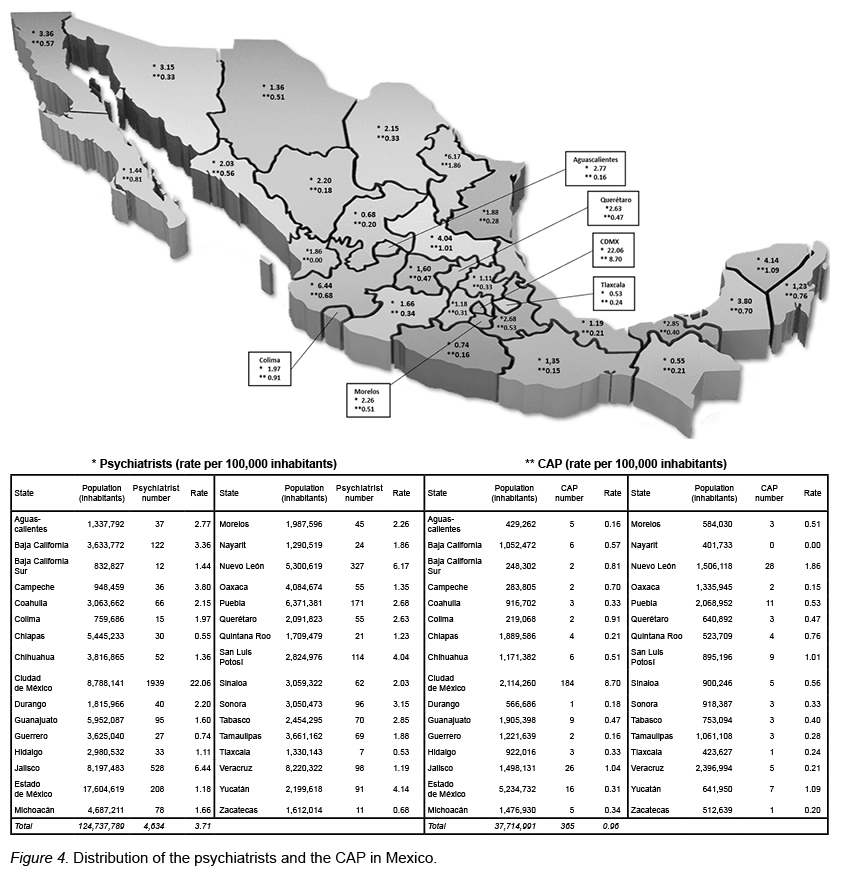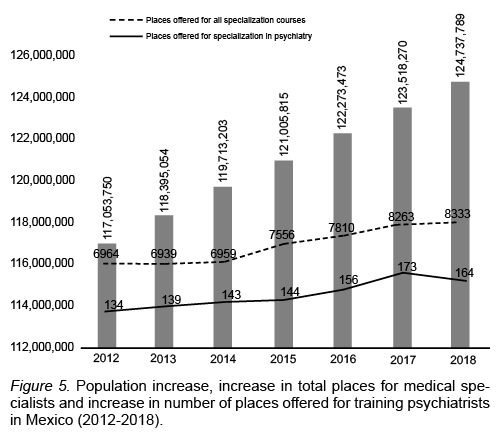Introduction
Worldwide, there are major health challenges such as overweight, obesity, diabetes, and other non-communicable diseases. Mexico is no exception (WHO, 2013a; SS, 2018; IHME, 2018). At the same time, the comorbidity of physical ailments with mental disorders is of interest, since the latter increase the risk of suffering and complicate the clinical evolution of communicable and noncommunicable diseases (OPS, 2014a). A widely studied example is the presence of comorbid depressive disorder with other noncommunicable diseases, which decreases the likelihood of adhering to treatments or medical recommendations (Di Mateo et al., 2000) and therefore poses an increased risk of early chronicity, disability, and mortality. In the event of comorbidity with infectious diseases, the consequence would be non-compliance with the therapeutic regimen, which could lead to microbial resistance to existing medications. The negative impact of depressive comorbidity on the quality of life and various functional aspects of people with physical illnesses is also related to an increase in health service use and the associated costs (Ciechanowshi et al., 2000). In the case of highly specialized treatments, such as radiotherapy, chemotherapy, or antiviral combinations for HIV treatment, failure to consider depressive comorbidity may lead to significant economic losses and negative clinical results.
In order to provide a more detailed, regional vision of the mental health status of countries and territories affiliated to the Pan American Health Organization/World Health Organization (OPS, 2015), the Mental Health Atlas was drawn up in 2001. Since then, three updates have been published (2005 [WHO, 2005], 2011 [WHO, 2011] and 2014 [WHO, 2014]). Among other data, this report provides up-to-date information on the availability of mental health resources and services worldwide. According to the 2014 Mental Health Atlas (WHO, 2014), the world average is 21.1 mental health workers per 100,000 inhabitants in the geographical areas evaluated (including psychiatrists, psychologists, nurses, social workers, and occupational therapists). There are significant differences between the subregions: a larger workforce was reported in the non-Latin Caribbean with a rate of 69.2 professionals, whereas in South America, the rate was 27.7, and in Central America, Mexico, and the Latin Caribbean, there were only 8.7 professionals per 100,000 inhabitants (OPS, 2015). Specifically, the average rate of psychiatrists for the Americas region was two for every 100,000 inhabitants. As for the rate of psychiatrists in Mexico, there are, on the one hand, the figures reported by the WHO, which probably reflect data on psychiatrists who are mainly affiliated to public sector hospitals (WHO, 2014). However, Heinze et al. (Heinze et al., 2012; Heinze et al., 2016) expanded the knowledge about the total number of psychiatrists in both the public and private sectors. They added two significant findings worth highlighting: 1. Only 19.39% of the psychiatrists had a valid certification in 2016 (Heinze et al., 2016), and 2. 60.34% of all the psychiatrists are concentrated in three states: 42.09% in Mexico City, 11.22% in Jalisco, and 7.03% in Nuevo León (Heinze et al., 2016). However, this publication does not mention the update on the number of child and adolescent psychiatry specialists, which amounted to 225 in 2011 (Heinze et al., 2012). These studies make it possible to create a current overview of the country and propose incremental measures for training professionals in psychiatry. They also underline the need for the continuous updating of the census of specialists in conjunction with the population increase, in order to determine whether they comply with the requirements established by international organizations, but mainly with the current demands of society and epidemiological needs.
The purpose of this study is to update the national longitudinal perspective for the total number of psychiatrists and child and adolescent psychiatrists (CAP) in 2018, including: geographical distribution, the number of physicians certified by the Consejo Mexicano de Psiquiatría (CMP), and the rate per 100,000 inhabitants, which will be contrasted with WHO recommendations.
Method
A descriptive, comparative longitudinal study was undertaken by consulting the following information sources:
-
Dirección General de Profesiones (General Directorate of Professions) of the Secretaría de Educación Pública (Secretariat of Public Education).
-
Asociación Psiquiátrica Mexicana AC (APM) (Mexican Psychiatric Association).
-
Asociación Mexicana de Psiquiatría Infantil AC (AMPI) (Mexican Association of Child Psychiatry) (AMPI).
-
Consejo Mexicano de Psiquiatría AC (CMP) (Mexican Council of Psychiatry).
-
Institutes and hospitals with places for practicing and/or taking the specialty course in psychiatry and child and adolescent psychiatry: Servicios de Atención Psiquiátrica of the Secretaría de Salud of the Gobierno Federal, Instituto Nacional de Psiquiatría Ramón de la Fuente Muñiz (INPRFM), Hospital Psiquiátrico Fray Bernardino Álvarez (HPFBA), Instituto Mexicano del Seguro Social (IMSS), Instituto de Salubridad y Seguridad Social para los Trabajadores del Estado (ISSSTE), Petróleos Mexicanos (PEMEX), Secretaría de Salubridad y Asistencia (SA), and the Hospital Psiquiátrico Infantil Dr. Juan N. Navarro (HPIJNN).
-
Private organizations offering treatment for mental illness.
-
Telephone directories and pharmaceutical industry directories.
-
Instituto Nacional de Estadística, Geografía e Informática (INEGI).
-
Consejo Nacional de Población (CONAPO).
Specialists in psychiatry and child and adolescent psychiatry who had emigrated, as well as those who had been counted in previous studies but who had died or were no longer practicing were excluded. A comparison was made between the data obtained in this study and the results published in 2011 and 2016.
Procedure
Once the study was approved by the División de Investigación y Ética of the Facultad de Medicina of the UNAM, the following data were obtained from the afore-mentioned sources: the names, gender, and location of specialists in psychiatry and child and adolescent psychiatry.
Due to the fact that the records of the various offices, institutions, and organizations could include the same person in different states, contact was established via email to accurately determine their current location, eliminating duplicate information in the records to create an updated, revised, corrected, and accurate database of each of the specialists distributed by state.
In order to determine the rate of psychiatrists and pediatricians for every 100,000 inhabitants, both nationally and by state, data from INEGI and CONAPO were used.
The rates of psychiatrists and CAP were calculated at the national and federal level, comparing it with the average of those obtained in other countries according to the classification established by the WHO, which divides countries into four groups: high-income, medium-high income, medium-low income, and low-income countries. Lastly, the number of psychiatrists and CAP was counted by gender, and the percentage of certified and recertified psychiatrists and CAP and those current registered with the CMP, as well as members of the respective associations, APM/AMPI, was calculated.
This study complies with the requirements established by the Federal Law on personal data protection, guaranteeing the privacy of individuals and their right to information security.
Results
In accordance with the various search sources and the records made (which were systematically reviewed and refined), a total of 4,634 physicians specializing in psychiatry were registered in May 2018, 365 of whom were specialized in child and adolescent psychiatry.
Certification and membership of medical associations of the specialty. The entity responsible for certifying specialists in psychiatry and child and adolescent psychiatry is the CMP, which determines whether specialist doctors meet the requirements of knowledge, experience, and training after completing a training program offered and accredited by a national or foreign higher education or health institute. In May 2018, there were 2,502 psychiatrists registered with the CMP (53.9% of the total number of psychiatrists in the country), only 1,139 of whom (24.6% of the total) have current certification. At the same time, the APM has a register of 2,547 active members with a degree in psychiatry (54.9% of the total in the country) ( Figure 1 ).
As for CAP, 146 are registered with the CMP (40% of the total number of CAP in the country), only 77 of which (21.09% of the total) have current Board certification. The AMPI has a record of 53 active members with a degree in child psychiatry (14.5% of the total in the country).
Distribution by sex. Of the total number of psychiatrists counted, 2,965 are male and 1,669 female. In other words, there is a ratio of 1.78 male psychiatrists to every female psychiatrist.
With regard to specialists in child and adolescent psychiatry, 189 are male and 176 female; in other words, there is a 1:1 ratio of male and female CAP.
Rate per 100,000 inhabitants. Considering the total number of psychiatrists in Mexico, for an estimated population of 124,737,789 according to the CONAPO population projections for 2018 (CONAPO, 2010), a rate of 3.71 psychiatrists per 100,000 inhabitants was obtained ( Figure 2 ).
Regarding child and adolescent psychiatry specialists, if we only consider the population under 16 years, 37,714,991 inhabitants (CONAPO, 2010), the rate would be .96 CAP per 100,000 children ( Figure 3 ).
Geographical distribution. Based on the results, one can see that all the states in Mexico have at least one psychiatrist. The three states with the highest number of psychiatrists account for 60.3% (n = 2794) of the total in Mexico, and are distributed as follows: a) 41.8% practiced their specialty in Mexico City (n = 1939, 22.06 psychiatrists/100,000 inhabitants), b) followed by Jalisco with 11.4% (n = 528, 6.44 psychiatrists/100,000 inhabitants), and c) and Nuevo León with 7% (n = 327, 6.17 psychiatrists/100,000 inhabitants). The remaining 39.7% (n = 1840) were distributed in the remaining states, mainly in urban areas. Tlaxcala (.15%, n = 7), Zacatecas (.23%, n = 11) and Baja California Sur (.25%, n = 12) were the states with the lowest number of psychiatrists ( Figure 4 ).
CAP are also concentrated in the most densely populated areas. A total of 51.7% practiced in Mexico City (n = 184, 8.7 CAP/100,000 minors), 7.9% in Nuevo León (n = 28, 1.86 CAP/100,000 minors), and 7.1% in Jalisco (n = 26), 1.04 CAP/100,000 minors); with the other 35.6% (n = 127) being distributed among the remaining 29 states in the country. An increase was registered in the geographical areas with coverage of CAP compared to the data from 2011. In three states (Durango, Tlaxcala, and Zacatecas), only one professional per state practiced child and adolescent psychiatry, while Nayarit does not have any CAP ( Figure 4 ).
Discussion
Since the publication by Heinze et al. in 2012 (Heinze et al., 2012), there has been a 21% increase in the total number of psychiatrists (from 3,823 to 4,634 specialists) and a 62.2% increase in the total number of CAP (from 225 to 365). The rate of psychiatrists in Mexico registered a 9.11% increase during this last period (from 3.4 psychiatrists per 100,000 inhabitants in 2011 to 3.71 in 2018). This increase is low compared to that of developed countries. At this rate of growth, it will take several years for Mexico to report similar rates to countries such as Finland (23.6/100,000 inhabitants), France (22.77/100,000 inhabitants), Spain (10.56/100,000 inhabitants) (Eurostat data, 2017), and the United States (7.70/100,000 inhabitants) (Sawyer, 2017). The number of mental health care specialists is insufficient to cover needs in Mexico, since, according to the WHO (WHO, 2014), a minimum of five psychiatrists per 100,000 inhabitants is required. This does not even consider the uneven, heterogeneous distribution of specialists throughout the country.
According to INEGI (INEGI, 2017) there are 352,305 physicians in Mexico. According to Heinze et al (Heinze et al., 2018), 147,910 of these are specialists. Comparing the present information with the data obtained in this study, it was calculated that psychiatrists account for 1.4% of the total number of doctors and for 3.35% of the total number of specialists.
The demographic transition currently being experienced by the Americas raises major challenges which mental health services must address (Kohn, 2013; Berenzon et al., 2013; Rodríguez et al., 2009; WHO, 2009; OPS, 2011):
-
Psychiatric disorders, such as depression, anxiety, schizophrenia, neurodevelopmental disorders, and others, significantly contribute to the increase in the burden of noncommunicable diseases (WHO, 2012). It is estimated that between 450 and 500 million people worldwide had a mental disorder in 2016 (Benjet & Scott, 2016; WHO, 2017; Medina-Mora et al., 2007). The WHO estimates that over 300 million suffer from depression (WHO, 2017). In Mexico, according to the Encuesta Nacional de Salud Mental (Medina-Mora et al., 2007), 18% of the urban population of productive age (15-64 years) suffer from a mental disorder such as anxiety, depression, or phobia. Moreover, there are three million people with alcohol use disorders, 13 million with tobacco use disorders, and over 400,000 who use psychotropic drugs. Lastly 8.5% of the years lost because of illness are due to depressive disorders (Gómez-Dantes et al., 2016).
-
The size of the care gap (percentage of people who need care and do not receive it) (Kohn, 2013) and the treatment gap (serious cases which have not received treatment in the past 12 months). In low- and medium-income countries, between 76% and 85% of the people with severe mental disorders fail to receive treatment. This figure is also high in high-income countries: between 35% and 50%. About the main mental disorders, the treatment gap in the Americas region is as follows: 60.1% for affective disorders, 63.1% for anxiety disorders, and 71.4% for substance use in adults (Berenzon et al., 2013). Currently, only 20% of the people with a mental disorder in Mexico receive treatment (Gómez-Dantes et al., 2016).
-
In the Americas, the age-adjusted suicide rate, per 100,000 inhabitants, is 7.3 (11.5 men and three women). Worldwide, suicide is the third leading cause of death in the group aged 20 to 24 years, and the fourth leading cause in the groups aged 10 to 19 and 25 to 44. The population over 70 has the highest rate (12.4 per 100,000 inhabitants) (OPS, 2014b). In Mexico, it has been documented that between 1% and 2% of the adult population have attempted suicide (Hernández-Bringas & Flores-Arenales, 2011). Moreover, nearly one million people commit suicide a year, exceeding the number of deaths caused by wars and natural disasters (Benjet & Scott, 2016; WHO, 2017; Medina-Mora et al., 2007). According to INEGI (2017), between 2000 and 2016, the suicide rate in Mexico rose from 3.5 to 5.1 cases per 100,000 inhabitants. Mental disorders are the main risk factor for suicide and other types of self-inflicted injuries such as cuts, burns, wounds, and poisoning. The volume of suicides varies between geographical areas and states. In 2016, the states with the highest suicide rates were Chihuahua and Yucatán with 11.4 and 10.2 suicides per 100,000 inhabitants, respectively (INEGI, 2018).
-
Violence constitutes an important social and health problem, which mainly affects women and leads to multiple health consequences, ranging from depression to death from suicide (WHO, 2013b). Violence against children also creates intergenerational cycles of violence, with the same consequences.
-
There are enormous inequalities in mental health care at the international level. For example, in low- and middle-income countries, public spending on mental health is less than two dollars per capita, whereas in high-income countries, it amounts to an average of $58.73 per capita. In Mexico, the mental health budget in 2017 was $2.586 billion pesos (equivalent to 2.2% of the budget of the Secretaría de Salud). This percentage is below the average of countries with the same income level, such as Brazil, Costa Rica and Colombia, which allocate 2.4%, 2.9%, and 10%, respectively (SHCP, 2017; Congress of Colombia, 2013). The WHO recommends that between 5% and 10% of the budget be spent on health (WHO, 2013a).
-
A significant increase has been observed in the demand for mental health care in primary care units. However, one of the main problems is that most primary care physicians are unfamiliar with the diagnostic manuals and treatment of psychiatric conditions.
Considering that in Mexico less than 15% of the personnel in health units received refresher courses and/or education on mental health issues (Medina-Mora et al., 2005; Borges et al., 2007), it would be advisable to implement a training program for first-contact physicians.
The importance of mental health for the maintenance of physical health is now a well-established fact. There is significant interaction between risk factors from the emotional and psychosocial environment and the emergence and/or prognosis of various physical illnesses (WHO, 2017; Government of Chile, 2017). However, it should be noted that there are not only repercussions at the individual and family level, since mental illnesses can lead to a reduction in work performance which in turn translates into greater absenteeism, with a significant impact on society and economic development (Pinedo Acosta, 2011).
Regarding child and adolescent psychiatry, between 10% and 20% of children and adolescents worldwide experience some type of mental disorder. Half of all mental illnesses begin at a fairly early age (WHO, 2017; WHO, 2013c). Neuropsychiatric diseases are the leading cause of disability in young people around the world. If they are not treated, they severely impact children’s development, their school achievements, and their potential to live a normal, productive life. Children with mental illnesses face challenges such as stigma, isolation, and discrimination, as well as lack of access to health and education services (WHO, 2013d).
In addition to the afore-mentioned disorders, there are those produced as a result of domestic violence. There is extensive literature to support the fact that abused children are more prone to suffer psychiatric disorders in the course of their whole lives. In particular, they are more likely to develop major depression (Scott et al., 2010; Green et al., 2010; Danese et al., 2009), bipolar disorder (Danese et al., 2009), anxiety disorders (Scott et al., 2010; Green et al., 2010; Cougle et al., 2010), post-traumatic stress disorder (Scott et al., 2010; Green et al., 2010), substance abuse (Anda et al., 2007; Scott et al., 2010; Dube et al., 2003; Lewis et al., 2016), personality disorders (Peng et al., 2011; Elices et al., 2015), and psychosis (Cutajar et al., 2010).
As expected, the results indicate a greater concentration of CAP with professional practice in Mexico City and the states of Jalisco and Nuevo León, which contrasts with fifteen states that have three or fewer specialists in child and adolescent psychiatry. This makes it impossible to meet the care needs of children and adolescents and guarantee their fundamental right to comprehensive health (both physical and mental).
To narrow the gap between the training of human resources in health and the needs of the population, from 2012 to 2017 the Comisión Interinstitucional para la Formación de Recursos Humanos para la Salud (CIFRHS, 2018) increased the number of places for training psychiatrists in Mexico by 27.3% (from 139 to 173). However, in 2018 the number of available places was reduced to 164. Accordingly, human resources for mental health care are insufficient and not commensurate with the significant increase in morbidity and mortality caused by mental illnesses ( Figure 5 ).
At present, the psychiatry specialization course lasts four years, is taught at 22 institutions, and has the support of 16 universities (CIFRHS, 2018; De la Fuente & Heinze, 2014). Conversely, Child and Adolescent Psychiatry lasts for two years, is taught at five institutions, and has the support of UNAM (De la Fuente & Heinze, 2014).
In 2018, in Mexico, one in four psychiatrists (24.6%) was currently certified by the Consejo Mexicano de Psiquiatría. This data is not very encouraging, especially if we compare it with the percentage of specialists certified in other specialties (Heinze et al., 2018). However, the increase in the number of specialists who have acquired the category of current certificate is significant. By May 2018, there was a net increase of 287 specialists in comparison with 2016 (852 psychiatrists in 2016 to 1139 in 2018). This figure is 3.7 times the increase from 2011 to 2016 (from 776 to 852). These significant data show the impact of recent amendments to the law regarding the monitoring of certification (SS, 2011), and the joint effort by the Consejo Mexicano de Psiquiatría and the Asociación Mexicana de Psiquiatría to increase the number of certified psychiatrists as a training measure and a means of continuously updating their skills. Regarding CAP, we are unable to establish a comparison because this is the first census of this specialty to take into account the status of certification by the CMP, with only one in five CAP having up-to-date certification.
Lastly, one of the limitations of this study is the limited availability of data. Only psychiatrists on which there was information in any of the many databases could be counted and located. One variable to be considered in future studies would be to know the total number of psychogeriatricians practicing in the country, taking into account the fact that the number of people with dementia will double every 20 years (WHO, 2012).
Considering that a high percentage of the Mexican population will consult a doctor for a mental health problem, including alcoholism and addictions, close follow-up must be given to comply with the objectives of the Programa de Acción Específica (PAGE) del Gobierno Federal en Salud Mental 2013-2018: 1. strengthen and modernize psychiatric care services with a comprehensive, multidisciplinary community approach; 2. formalize the Specialized Psychiatric Care Network to achieve greater efficiency; 3. undertake prevention and education actions for priority mental disorders and their risk factors; 4. promote the training of researchers and specialists in accordance with the leading mental illnesses; and 5. encourage mental health research and the development of community care models (SS, 2013).
Funding
None.
Conflicts of interest
The authors declare they have no conflict of interest.
Acknowledgements
The authors are grateful to the Consejo Mexicano de Psiquiatría, the Asociación Mexicana de Psiquiatría and the Asociación Mexicana de Psiquiatría Infantil.
